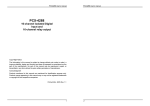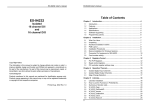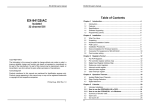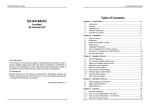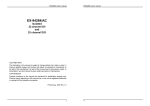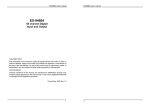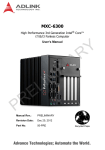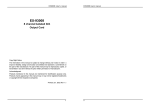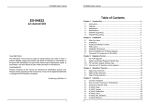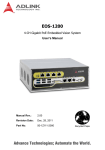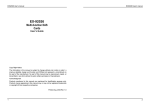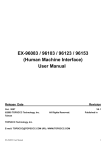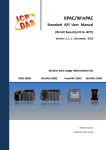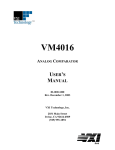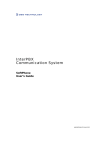Download Manual - TopsCCC
Transcript
EX-94288 User’s manual EX-94288 User’s manual Table of Contents Chapter 1 Introduction......................................................................................4 1.1 1.2 1.3 1.4 1.5 1.6 EX-94288 16-channel isolated Digital Input and 16-channel relay output Introduction ................................................................................................4 Features ....................................................................................................4 Applications ...............................................................................................4 Specifications.............................................................................................5 Software Supporting ..................................................................................6 Programming Library .................................................................................6 Chapter 2 Installation........................................................................................7 2.1 2.2 2.3 2.4 2.5 2.6 2.7 What You Have ..........................................................................................7 Unpacking..................................................................................................7 Hardware Installation Outline .....................................................................7 PCB Layout................................................................................................8 Installation Procedures ..............................................................................9 Device Installation for Windows Systems ..................................................9 Connector Pin Assignment of EX-94288....................................................10 Chapter 3 Registers Format .............................................................................12 3.1 3.2 3.3 PCI PnP Registers.....................................................................................12 Digital Input/Output Register Address Map ................................................13 PCI controller register address map ..........................................................13 Chapter 4 Jumper setting .................................................................................15 Copy Right Notice The information in this manual is subject to change without prior notice in order t o improve reliability, design and function and does not represent a commitment on the part of the manufacturer. No part of this manual may be reproduced, copied, or transmitted in any form without the prior written permission of manufacturer. Acknowledgment Products mentioned in this manual are mentioned for identification purpose only. Products manes appearing in this manual may or may not be registered trademarks or copyright of their respective companies Printed Sep. 2002 Rev 1.0 1 4.1 Card number setting ..................................................................................15 Chapter 5 Operation Theorem..........................................................................16 5.1 5.2 5.3 Digital Input Channels................................................................................16 Digital Output Channels .............................................................................16 Edge Change Detection.............................................................................17 Chapter 6 Libraries............................................................................................18 6.1 6.2 6.3 6.4 6.5 6.6 6.7 6.8 6.9 6.10 6.11 2 Libraries Installation ...................................................................................18 How to use the Functions in PCIDAQ.DLL ................................................18 Summary of function calls..........................................................................19 W_4288_Open...........................................................................................20 W_4288_GetCardsID: ...............................................................................21 W_4288_Version .......................................................................................22 W_4288_GetBusSlot .................................................................................23 W_4288_Close ..........................................................................................24 W_4288_ReadDI .......................................................................................25 W_4288_WriteRelay ..................................................................................26 W_4288_ReadRelay ..................................................................................27 EX-94288 User’s manual 6.12 6.13 6.14 6.15 6.16 6.17 W_4288_Set_RelayBit .............................................................................. 28 W_4288_Reset_RelayBit .......................................................................... 29 D_4288_Read_IntStatus ........................................................................... 30 W_4288_Clear_IntStatus .......................................................................... 31 W_4288_IntEnable ................................................................................... 32 W_4288_IntDisable................................................................................... 33 EX-94288 User’s manual Chapter 1 Introduction 1.1 Chapter 7 EX-9837 Terminal board.................................................................. 34 7.1 Introduction The EX-94288 is a 16-ch relay actuator and 16-ch isolated digital input card for the PCI bus. Its sixteen on-board SPDT relays are ideal for applications such as device ON/OFF control or small power switched. For easy monitoring, each relay is equipped with one red LED to show its ON/OFF status. Main features ............................................................................................ 34 The EX-94288’s sixteen optically-isolated digital input channels are ideal for digital input in noisy environments or with floating potentials. This I/O card fully implements the PCI local bus specification Rev 2.1. All bus relative configurations, such as base memory and interrupt assignment, are automatically controlled by BIOS software. 1.2 Features The EX-94288 isolated digital I/O card provide the following advanced features: 16 relay output channels and 16 isolated digital input channels LED indicators to show activated relays Output status read-back Keep relay output values when hot system software reset High-voltage isolation on input channels (2,500 V DC ) On-board digital filter circuit High over-voltage protection (70 V DC ) Wide input range (0 ~ 30 V DC ) Interrupt handling capability 37-pin D-type connector Board card number 1.3 Applications Laboratory and Industrial automation Industrial ON/OFF control Switch status sensing PC-based Industrial Machinery Testing & Measurement Laboratory & Education External relay driving 3 4 EX-94288 User’s manual 1.4 EX-94288 User’s manual 1.5 Specifications Relay Outputs Software Supporting Topsccc provides versatile software drivers and packages for users’ different approach to built-up a system. We not only provide programming library such as DLL for many Windows systems, but also provide drivers for many software package such as LabVIEW™ ,Intouch™ and so on. All the software options are included in the provided CD. Contact Rating: 0.3A/120V AC,DC/1A 30V DC Contact arrangement: Output channel 0 -3 are form C Output channel 4-7 are Form A 1.6 Operating time: 5 mSec Release time: 10 mSec Programming Library The provided CD includes the function libraries for many different operating systems, including: Expected life > 100,000 times (at 30V, 1A) DOS Library: Borland C/C++ and Microsoft C++, the functions descriptions are included in this user’s guide. Isolated Inputs Type: opto-isolated (PC-814) Windows 98/2000/NT/Me/XP DLL: For VB, VC++, BC5, the functionsDescriptions are included in this user’s guide. Input voltage: DC 5-24V (0- 1KHz) Input impedance: 4.7K ohm (or optional 47K ohms for +24Vdc input range) Windows 98/2000/NT/Me/XP ActiveX: For Windows’s applications Response time: 20u Sec LabVIEW ® Driver: Contains the VIs, which are used to interface with NI’s LabVIEW ® software package. Supporting Windows 95/98/NT/2000. The LabVIEW ® drivers are free shipped with the board. Isolated: 500v channel-channel / channel - Ground Interrupt: Pos. or Neg. edge interrupt programmable (Ch #0,Ch #8) InTouch Driver: Contains the InTouch driver which support the Windows 98/2000/NT/XP. The The InTouch ® drivers are free shipped with the board. Software: Software Toolkit (DLL, ACtiveX) for Windows 98/2000/NT/XP Software Toolkit for Labview, Intouch Environmental: Power requirements: +5V 600mA (typical) Operation Temp: 0 to 50C Storage Temp: -20 to 70C Humidity: 0 to 90% none-condensing Dimensions: 180 X 105 mm 5 6 EX-94288 User’s manual EX-94288 User’s manual 2.4 Chapter 2 PCB Layout Installation 165 mm This chapter describes how to install the EX-94288 card. Please follow the follow steps to install the EX-94288 card. 2.1 CN1 What You Have In addition to this User's Manual, the package includes the following items: 1 102 mm EX-94288 board Driver/utilities CD This user’s manual If any of these items is missing or damaged, contact the dealer from whom you purchased the product. Save the shipping materials and carton in case you want to ship or store the product in the future 2.2 PCI Bus Controller Unpacking ID Your EX-94288 card contains sensitive electronic components that can be easily damaged by static electricity. The operator should be wearing an anti-static wristband, grounded at the same point as the anti-static mat. Inspect the card module carton for obvious damage. Shipping and handling may cause damage to your module. Be sure there are no shipping and handing damages on the module before processing. CN1: Optical digital input and relay channel #0~channel #7 connector JP1: Relay channel #8~channel #15 connector ID: Card number selection jumper Hardware Installation Outline PCI configuration The PCI cards are equipped with plug and play PCI controller, it can request base addresses and interrupt according to PCI standard. The system BIOS will install the system resource based on the PCI cards’ configuration registers and system parameters (which are set by system BIOS). Interrupt assignment and memory usage (I/O port locations) of the PCI cards can be assigned by system BIOS only. These system resource assignments are done on a board-by-board basis. It is not suggested to assign the system resource by any other methods. PCI slot selection The PCI card can be inserted to any PCI slot without any configuration for system resource. 7 JP1 Where After opening the card module carton, extract the system module and place it only on a grounded anti-static surface component side up. Again inspect the module for damage. Press down on all the socketed IC's to make sure that they are properly seated. Do this only with the module place on a firm flat surface. 2.3 4 3 2 1 8 EX-94288 User’s manual 2.5 EX-94288 User’s manual 2.7 Installation Procedures 1. Turn off your computer. Connector Pin Assignment of EX-94288 There are two connectors labeled “CN1” and “CN2”. The CN1 connector is a 37-pin D-type connector and CN2 connector is a 40-pin FRC connector. 2. Turn off all accessories (printer, modem, monitor, etc.) connected to your computer. The CN2 can be converted to 37-pin D-type connector by using converting cable attached in the package. 3. Remove the cover from your computer. The pin assignment of the CN2 (37-pins D-type connector) includes the isolated digital input channels (DI_0~DI_15) and relay output channels (Relay_0~Relay_7) 4. Setup jumpers on the card. 5. Before handling the PCI cards, discharge any static buildup on your body by touching the metal case of the computer. Hold the edge and do not touch the components. The CN2 pin assignment is as shown in Figure 2-1 6. Position the board into the PCI slot you selected. (19) COM_0 COM_7 (37) (18) NO_0 7. Secure the card in place at the rear panel of the system. 2.6 NO_7 (36) (17) DI_GND COM_6 (35) Device Installation for Windows Systems (16) DI_15 NO_6 (34) Once Windows 95/98/2000 has started, the Plug and Play function of Windows system will find the new Expert cards. If this is the first time to install Expert cards in your Windows system, you will be informed to input the device information source. (15) DI_14 COM_5 (33) (14) DI_13 NO_5 (32) (13) DI_12 COM_4 (31) (12) DI_11 NO_4 (30) (11) DI_10 NC_3 (29) (10) DI_9 COM_3 (28) (9) DI_8 NO_3 (27) (8) DI_7 NC_2 (26) (7) DI_6 COM_2 (25) (6) DI_5 NO_2 (24) (5) DI_4 NC_1 (23) (4) DI_3 COM_1 (22) (3) DI_2 NO_1 (21) (2) DI_1 NC_0 (20) (1) DI_0 CN2 Figure 2-1 Pin Assignment of EX-94288 connector CN2 Legend: DI_n: Digital input /output channel #n DI_GND: Ground return path of input channels NO_n: Relay output channel #n (normal open) NC_n: Relay output channels #n (normal close) COM_n: Relay common #n 9 10 EX-94288 User’s manual EX-94288 User’s manual The CN1 pin assignment is as shown in Figure 2-2 Chapter 3 Registers Format (18) NC_13 (17) COM_13 (16) NO_13 (15) NC_12 (14) COM_12 (13) NO_12 Converting cable (12) NC_11 (11) COM_11 (10) NO_11 (9) NC_10 (8) COM_10 (7) NO_10 NC_15 (25) COM_15 (24) NO_15 (23) NC_14 (22) COM_14 (21) NO_14 (20) 39 37 35 33 31 29 27 25 23 21 19 17 15 13 11 9 7 5 3 1 40 38 36 34 32 30 28 26 24 22 20 18 16 14 12 10 8 6 4 2 This information is quite useful for the programmers who wish to handle the card by low-level programming. However, we suggest user have to understand more about the PCI interface then start any low-level programming. In addition, the contents of this chapter can help users understand how to use software driver to manipulate this card. (18) NC_13 (17) COM_13 (16) NO_13 (15) NC_12 (14) COM_12 (13) NO_12 (12) NC_11 (11) COM_11 (10) NO_11 (9) NC_10 (8) COM_10 (7) NO_10 (6) NC_9 (5) COM_9 (4) NO_9 (3) NC_8 (2) COM_8 (1) NO_8 3.1 There are two types of registers: PCI Configuration Registers (PCR) and Peripheral Interface Bus (PIB). The PCR, which is compliant to the PCI-bus specifications, is initialized and controlled by the plug & play (PnP) PCI BIOS.. The PCI bus controller Tiger 100/320 is provided by Tigerjet Network Inc. (www.tjnet.com). For more detailed information of PIB, please visit Tigerjet technology’s web site to download relative information. It is not necessary for users to understand the details of the PIB if you use the software library. The PCI PnP BIOS assigns the base address of the PIB. The assigned address is located at offset 14h of PIB . NC_15 (25) CN1 (6) NC_9 COM_15 (24) (5) COM_9 PCI PnP Registers (n): pin number of 37-pin D-type connecto NO_15 (23) (4) NO_9 NC_14 (22) (3) NC_8 COM_14 (21) (2) COM_8 NO_14 (20) (1) NO_8 The EX-94264 board registers are in 32-bit width. But only lowest byte (bit0~bit7) is used. The users can access these registers by only 32-bit I/O or 8-bit I/O instructions. The following sections show the address map, including descriptions and their offset addresses relative to the base address. CN1 Figure 2-2 Pin Assignment of EX-94288 connector CN1 Legend: NO_n: Relay output channel #n (normal open) NC_n: Relay output channels #n (normal close) COM_n: Relay common #n 11 12 EX-94288 User’s manual 3.2 EX-94288 User’s manual Interrupt status register Digital Input/Output Register Address Map Read the interrupt status of DI_0 and/or DI_8 channels or clear the interrupt status register There are 16 isolated digital inputs and 16 relay output channels on EX-94288, each bit of based address is corresponding to a signal on the digital input or output channel. 3.3 Address: Base+0C8h Attribute: Read/write PCI controller register address map Value: Reset control register Write: any data to clear interrupt status The EX-94288 is in inactive state when the system power on, and should be activated by set bit o of this register to “1” state Read: bit #0= DI_0 interrupt, bit #1=DI_8 interrupt Address: Base + 0x00h I/O control registers Attribute: Write only Address: Base + 0C0h~Base + 0E0h Value: 01 Attribute: Read/Write PCI Internal special control register Value: EX-94288 internal control register, should be written with value 0FH before controlling EX-94288 card Port Address: Base + 002h Attribute: Write only Base+0C0h Mode Function Write Write data to relay output port #0 (NO_0~NO_7) Read Read back current relay port #0 data (NO_0~NO_7) Value: always are 0Fh Interrupt mask control register Write Write data to relay output port #1 (NO_8~NO_15) Base+0C4h Enable or disable PCI interrupt INT #A Read Address: Base + 0x05h Read back current relay port #1 data (NO_8~NO_15) Base+0CC Write No used h Read Read digital input port #0 (DI_0~DI_7) Attribute: Write only Value: 10H =enable PCI INT A# 00H=disable PCI INT #A Base+0E0h Interrupt mode control register Write No used Read Read digital input port #1 (DI_8~DI_15) Control the interrupt mode of DI_0 and DI_8 channels Table 3-1 Address: Base + 0x03h Attribute: Write only Value: bit #1=0 : Disable interrupt form DI_0 bit #1=1,bit #0=0 : Enable falling edge interrupt form DI_0 bit #1=1,bit #0=1 : Enable rising edge interrupt form DI_0 bit #3=0 : Disable interrupt form DI_8 bit #3=1,bit #2=0 : Enable falling edge interrupt form DI_8 bit #3=1,bit #2=0 : Enable rising edge interrupt form DI_8 13 14 EX-94288 User’s manual EX-94288 User’s manual Chapter 5 Chapter 4 Operation Theorem Jumper setting 4.1 5.1 Card number setting A jumper called “ID” (see page 8) on the card is used to set the card number starts from 1 to 4 ID Digital Input Channels The isolated digital inputs of EX-94288 can accept both dry contact input and voltage input (wet contact). The input voltage range form 0V to 24V and input resistor is 4.7K ohms (47K option). The connection between outside signal and EX-94288 is shown in Figure 5-3 Maximum four EX-94288 cards can be installed in system simultaneously with each has a unique card number. Dry contact input DC/DC +5V Card number 4.7K 4 3 2 1 1 (default setting) DI_n (0~15) ID DI_GND 4 3 2 1 2 ID Voltage input DC/DC +5V 4 3 2 1 4.7K 3 DI_n (0~15) ID + V 4 3 2 1 5 ~24V - DI_GND 4 ID Figure 5-3 digital inputs of EX-94288 5.2 Digital Output Channels On EX-94288, the COM_n pin is used as relay channel #n COMMON, NO_n pin is used as relay channel #n normal open output and NC_n pin is used as relay channel #n normal close output .The block as shown in Figure 5-4 COM_n coil COM NO NO_n loading NC_n NC Figure 5-4 relay output of EX-94288 15 16 + V - EX-94288 User’s manual 5.3 EX-94288 User’s manual Edge Change Detection Chapter 6 The ECD (Edge Change Detection) detection circuit is used to detect the edge of level change. In the EX-94288, the detection circuit is applied to two input channels (DIO_0 and DIO_8). If channel is programmed to be rising edge or falling edge interrupt mode, the ECD detection circuit generate an interrupt request, when the signal inputs are changed from low to high level or high to low level respectively Rising Edge Interrupt Libraries This chapter describes the software library for operating this card. Only the functions in DOS library and Windows 98/2000 DLL are described. Please refer to the PCIDAQ function reference manual, which included in Topsccc CD for the descriptions of the Windows 98/NT/2000 DLL functions. 6.1 DI_0 or DI_8 Libraries Installation The device drivers and DLL functions of Windows 98/NT/2000 are included in the PCIDAQ. The Topsccc CD also includes the detail examples and readme files ECD 6.2 INT How to use the Functions in PCIDAQ.DLL VC++6.0: Generate Interrupt 1. Add file '../Include/PCIDAQ.H' in your project 2. In link page of menu project| setting, add '../LIB/PCIDAQ.LIB' in the blank of Objects/Library Modules 3. Add this sentence "#include '../Include/PCIDAQ.H' " to the head of your main file. Falling Edge Interrupt DI_0 or DI_8 ECD Visual BASIC: INT 1. Add file '../Include/Declare.bas' in your project. Delphi: Generate Interrupt Figure 5-5 Debounce block diagram of EX-94288 1. Add file '../Include/Declare.pas' in your project 2. Add this sentence "uses Declare;" in the head of your unit.pas C++Builder: 1. Add file '../Include/PCIDAQ.H' and '../Lib/PCIDAQ_CB.lib' to your project 2. Add this sentence "#include '../Include/PCIDAQ.H' " to head of your main file. Note: For more information, please refer to program in directory '../Example/' 17 18 EX-94288 User’s manual 6.3 EX-94288 User’s manual 6.4 Summary of function calls W_4288_Open Description: Function Description Because the EX-94288 is PCI bus architecture and meets the plug and play design, the IRQ and base_address (pass-through address) are assigned by system BIOS directly. EX-94288 cards have to be initialized by this function before calling other functions. Page W_4288_Open Initial EX-94288 card before using other functions 20 W_4288_GetCardsID Get EX-94288 card number 21 W_4288_Version Get version number of PCIDAQ.DLL 22 23 W_4288_ReadDi Get PCI bus and slot number occupied by EX-94288 Close EX-94288 card before terminating program Read digital input port data (8-bit) 25 W_4288_WriteRelay Write data (8-bit) to digital output port 26 Function W_4288_Open (ByRef ExitedCards As Long) As Long W_4288_ReadRelay Read back current relay port value 27 Delphi Set a bit of port to high 28 Function W_4288_Open (var ExistedCards:Integer): Integer; W_4288_GetBusSlot W_4288_Close W_4288_Set_RelayBit Syntax: C/C++ (Dos) WORD D_4288_Open (WORD cardNo); C/C++ (Windows) 24 WORD D_4288_Open (WORD *ExistCards); Visual BASIC (Windows) W_4288_Reset_RelayBit Reset a bit of port to low 29 D_4288_Read_IntStatus Read interrupt status register (DOS only) 30 CardNo: card number be opened ( for DOS only) W_4288_Clear_IntStatus Clear interrupt status register 30 existCards: The number of installed EX-94288 cards. (for Windows only) W_4288_IntEnable Enable digital input change interrupt 31 W_4288_IntDisable Disable digital input interrupt 33 This return value shows how many EX-94288 cards are installed in your system. Argument: Return Code: Error code (Please refer to PCIDAQ.H or DOSDAQ.H) 19 20 EX-94288 User’s manual 6.5 EX-94288 User’s manual 6.6 W_4288_GetCardsID: Description: W_4288_Version Description: Get the cards number that is set by jumper on cards. PCIDAQ.DLL driver drives the EX-94288 cards. This function returns the version of PCIDAQ.DLL driver Syntax: Syntax: C/C++(DOS) void D_4232_GetCardsID(WORD *CardsIDArray); C/C++ (Dos) C/C++(Windows) void D_4288_Version(char *version) WORD W_4288_GetCardsID (WORD *CardsIDArray); C/C++ (Windows) Visual BASIC (Windows) WORD D_4288_Version (void) Function W_4288_GetCardsID (ByRef CardsIDArray As Long) As Integer Visual BASIC (Windows) Delphi Delphi Function W_4288_GetCardsID (var CardsIDArray:Word):Word; Function W_4288_Version ():Integer; Function W_4288_Version () As Long Argument: Return Code: CardsIDArray : This array return card number(1,2,3,4) which is set by jumper on card. You should define a 4 elements array, and then pass the array's pointer to this function. Version: Version string (DOS only) The version of PCIDAQ.DLL Return Code: Error code (Please refer to PCIDAQ.H or DOSDAQ.H) 21 22 EX-94288 User’s manual 6.7 EX-94288 User’s manual 6.8 W_4288_GetBusSlot Description: W_4288_Close Description: Get the PCI bus and slot occupied by EX-94288 The IRQ and base_address of EX-94288 (pass-through address) are assigned by system BIOS directly. This function should be called to release all system resource before terminate application program Syntax: C/C++ (Dos) WORD D_4288_GetBusSlot (WORD cardNo, WORD *bus,WORD *slot); Syntax: C/C++ (Dos) C/C++ (Windows) WORD D_4288_Close (WORD cardNo) W_4288_GetBusSlot (WORD cardNo, WORD *bus,WORD *slot); C/C++ (Windows) Visual BASIC (Windows) W_4288_Close (void) Function W_4288_GetBusSlot (ByVal cardNo As Long, ByRef bus As Long, ByRef slot As Long) As Long Visual BASIC (Windows) Delphi Function W_4288_Close () Function W_4288_GetBusSlot (cardNo:Integer; var portNo:Integer;var bitNo:Integer):Integer; Delphi Function W_4288_Close (); Argument: Argument: cardNo: card number (1,2,3,4),It's set by jumper on card None Bus: return PCI bus Number Return Code: Slot: return PCI slot Number of the bus None Return Code: Error code (Please refer to PCIDAQ.H or DOSDAQ.H) 23 24 EX-94288 User’s manual 6.9 EX-94288 User’s manual 6.10 W_4288_ReadDI Description: W_4288_WriteRelay Description: This function is used to read data from digital input port. There are two 8-bit digital inputs on the EX-94288. You can get 8-bit input data from EX-94288 by calling this function. Syntax: This function is used to write data to output port. There are two 8-bit digital outputs port on the EX-94288. You can send 8-bit output data to EX-94288 by calling this function. Syntax: C/C++ (Dos) C/C++ (Dos) WORD D_4288_ReadDI (WORD cardNo,WORD portNo,WORD *DiData) WORD D_4288_WriteRelay (WORD cardNo,WORD portNo,WORD Data); C/C++ (Windows) C/C++ (Windows) W_4288_ReadDI (WORD cardNo,WORD portNo,WORD *DiData) W_4288_WriteRelay (WORD cardNo,WORD portNo,WORD Data); Visual BASIC (Windows) Visual BASIC (Windows) Function W_4288_ReadDI (ByVal cardNo As Long, ByVal portNo As Long, ByRef DiData As Long) As Long Function W_4288_WriteRelay (ByVal cardNo As Long, ByVal portNo As Long, ByVal Data As Long) As Long Delphi Delphi Function W_4288_ReadDI (cardNo:Integer;portNo:Integer;var DoData:Integer): Integer; Function W_4288_WriteRelay (cardNo:Integer;portNo:Integer; Data:Integer): Integer; Argument: Argument: cardNo: Card number (1,2,3,4),It's set by jumper on card cardNo: Card number (1,2,3,4),It's set by jumper on card portNo: Digital Input port number (0 or 1) portNo: Relay output port number (0 or 1) DiData: return digital input data Data: Data be written to output port Return Code: Return Code: Error code (Please refer to PCIDAQ.H or DOSDAQ.H) Error code (Please refer to PCIDAQ.H or DOSDAQ.H) 25 26 EX-94288 User’s manual 6.11 EX-94288 User’s manual 6.12 W_4288_ReadRelay Description: W_4288_Set_RelayBit Description: This function is used to read current data of realy output port. There are two 8-bit digital outputs port on the EX-94288. You can read back 8-bit output data of EX-94288 by calling this function. Set a relay channel ON (energized) Syntax: C/C++ (Dos) Syntax: C/C++ (Dos) WORD D_4288_Set_RelayBit (WORD cardNo,WORD portNo,WORD bitNo); WORD D_4288_ReadRelay (WORD cardNo,WORD portNo,WORD *RelayData); C/C++ (Windows) W_4288_Set_RelayBit (WORD cardNo,WORD portNo, WORDbitNo); C/C++ (Windows) Visual BASIC (Windows) WORD W_4288_ReadRelay (WORD cardNo,WORD portNo,WORD *RelayData); Function W_4288_Set_RelayBit (ByVal cardNo As Long, ByVal portNo As Long, ByVal bitNo As Long) As Long Visual BASIC (Windows) Delphi Function W_4288_ReadRelay (ByVal cardNo As Long, ByVal portNo As Long, ByRef RelayData As Long) As Long Function W_4288_Set_RelayBit (cardNo:Integer;portNo: Integer; bitNo:Integer):Integer; Argument: Delphi cardNo: Card number (1,2,3,4),It's set by jumper on card Function W_4288_ReadRelay (cardNo:Integer;portNo:Integer; var DoData: Integer): Integer; portNo: Relay output port number (0 or 1) bitNo: Channel Number(0 to 7) Argument: Return Code: cardNo: Card number (1,2,3,4),It's set by jumper on card Error code (Please refer to PCIDAQ.H or DOSDAQ.H) portNo: Relay output port number (0 or 1) Data: Return current output data Return Code: Error code (Please refer to PCIDAQ.H or DOSDAQ.H) 27 28 EX-94288 User’s manual 6.13 EX-94288 User’s manual 6.14 W_4288_Reset_RelayBit Description: D_4288_Read_IntStatus Description: Set a relay channel Off (dis-energized) Get the interrupt status (for DOS only) Syntax: Syntax: C/C++ (Dos) C/C++ (DOS) WORD D_4288_Reset_RelayBit (WORD cardNo,WORD portNo,WORD bitNo); WORD D_4288_Read_IntStatus (WORD cardNo,WORD *IntStatus) Argument: C/C++ (Windows) cardNo: card number set by jumper on the card WORD W_4288_Reset_RelayBit (WORD cardNo,WORD portNo, WORD bitNo); IntStatus: return PCI interrupt status. if bit0 = 1,interrupted by channel 0 (DI_0) Visual BASIC (Windows) Function W_4288_Reset_RelayBit (ByVal cardNo As Long, ByVal portNo As Long, ByVal bitNo As Long) As Long if bit1 = 1,interrupted by channel 9 (DI_8) Return Code: Error code (Please refer to PCIDAQ.H or DOSDAQ.H) Delphi Function W_4288_Reset_RelayBit (cardNo:Integer;portNo: Integer; bitNo:Integer): Integer; Argument: cardNo: Card number (1,2,3,4),It's set by jumper on card portNo: Relay output port number (0 or 1) bitNo: Channel Number(0 to 7) Return Code: Error code (Please refer to PCIDAQ.H or DOSDAQ.H) 29 30 EX-94288 User’s manual 6.15 EX-94288 User’s manual 6.16 W_4288_Clear_IntStatus Description: W_4288_IntEnable Description: Clear interrupt by writing data to Base Port+0xC8 Enable Interrupt of channel #0 (DI_0) and/or channel #8 (DI_8) Syntax: Syntax: C/C++ (Dos) C/C++ (Dos) WORD D_4288_Clear_IntStatus (WORD cardNo); WORD D_4288_IntEnable (WORD cardNo,WORD Int1Mode, WORD Int2Mode,User_Interrupt_HANDLER userIntServiceRoutine); C/C++ (Windows) W_4288_Clear_IntStatus (WORD cardNo); C/C++ (Windows) Visual BASIC (Windows) Function W_4288_Clear_IntStatus (ByVal cardNo As Long) As Long WORD W_4288_IntEnable (WORD cardNo,WORD Int1Mode,WORD Int2Mode, User_Interrupt_HANDLER userIntServiceRoutine); Delphi Visual BASIC (Windows) Function W_4288_Clear_IntStatus(cardNo:Integer):Integer; Function W_4288_IntEnable (ByVal cardNo As Long, ByVal Int1Mode As Long, ByVal Int2Mode As Long, ByVal userIntServiceRoutine As Long) As Long Argument: cardNo: card number (1,2,3,4),It's set by jumper on card Delphi Return Code: Function W_4288_IntEnable (cardNo:Integer;Int1Mode:Integer; Int2Mode:Integer; userIntServiceRoutine:Pointer): Integer; Error code (Please refer to PCIDAQ.H or DOSDAQ.H) Argument: cardNo: card number (1,2,3,4),It's set by jumper on card Int1Mode: Interrupt mode of channel #0 (DI_0) Bit #0=1 or 0: rising or falling edge Interrupt Bit #1=1 or 0: enable/Disable interrupt Int2Mode: Interrupt mode of channel #8 (DI_8) Bit #0=1 or 0: rising or falling edge Interrupt Bit #1=1 or 0: enable/disable interrupt userIntServiceRoutine: user Interrupt service routine called when interrupt occurs. Return Code: Error code (Please refer to PCIDAQ.H or DOSDAQ.H) 31 32 EX-94288 User’s manual 6.17 EX-94288 User’s manual W_4288_IntDisable Chapter 7 Description: EX-9837 Terminal board Disable interrupt of digital input channel #0 (DI_0) and channel #8 (DI_8) Syntax: EX-9837 Screw-terminal termination board features one 37-pin D-type connector for easy maintenance, wiring, and installation. It provides 37 channels that are accessed through a 37-pin D-type connector. C/C++ (Dos) WORD W_4288_IntDisable (WORD cardNo); C/C++ (Windows) 7.1 WORD W_4288_IntDisable (WORD cardNo); Main features Low-cost screw-terminal board for the all Expert series with 37-pin D-type connector Visual BASIC (Windows) Function W_4288_IntDisable (ByVal cardNo As Long) Reserved space for signal-conditioning circuits such as low-pass filter, voltage attenuator and current shunt Delphi Industrial type termination blocks permit heavy-duty and reliable signal connections Function W_4288_IntDisable (cardNo:Integer); Argument: Table-top mounting using nylon standoffs. Screws and washers provided for panel or wall mounting cardNo: card number (1,2,3,4),It's set by jumper on card Return Code: Dimensions: 80mm (W) x 181mm (H) Error code (Please refer to PCIDAQ.H or DOSDAQ.H) 37-pin D-type connector 1 2 3 4 5 6 7 8 9 10 11 12 13 14 15 16 17 37 36 35 18 19 20 21 22 23 24 25 26 27 28 29 30 31 32 33 34 33 34

















